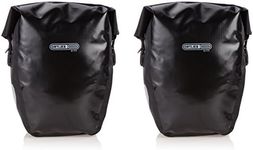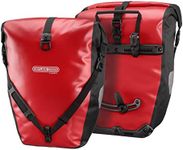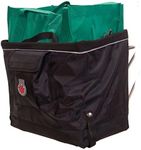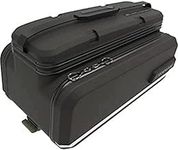Buying Guide for the Best Bicycle Rear Rack Bag
Choosing the right bicycle rear rack bag can make your rides more convenient and enjoyable, whether you're commuting, touring, or running errands. The best bag for you will depend on how much you need to carry, the type of riding you do, and your preferences for features like weather protection and ease of use. Understanding the key features will help you find a bag that fits your needs and makes your cycling experience smoother.CapacityCapacity refers to how much the bag can hold, usually measured in liters. This is important because it determines how much gear, groceries, or personal items you can carry. Small bags (5-10 liters) are great for carrying essentials like a repair kit, lunch, or a light jacket. Medium bags (10-20 liters) can handle a change of clothes, books, or a few groceries. Large bags (20 liters and above) are suitable for longer trips or carrying bulkier items. To pick the right capacity, think about what you usually need to bring with you on your rides and choose a size that comfortably fits those items without being too bulky.
Mounting SystemThe mounting system is how the bag attaches to your bike's rear rack. This is important because a secure and easy-to-use system will keep your bag stable and make it simple to put on and take off. Some bags use straps with buckles or Velcro, which are versatile and fit most racks but may take a bit longer to attach. Others use clip-on or quick-release systems, which are faster and more convenient but may only fit certain rack designs. Consider how often you'll need to remove the bag and whether you want maximum compatibility or quick access.
Weather ResistanceWeather resistance describes how well the bag protects your belongings from rain, splashes, and dust. This is important if you ride in different weather conditions or want to keep your items dry and clean. Some bags are made from water-resistant materials and have covered zippers, which can handle light rain. Others are fully waterproof with sealed seams, offering better protection in heavy rain. If you often ride in wet conditions or carry sensitive items like electronics, look for a bag with strong weatherproofing. For mostly dry rides, basic water resistance may be enough.
Compartments and OrganizationCompartments and organization refer to the number and type of pockets or dividers inside the bag. This is important for keeping your items organized and easy to find. Some bags have a single large compartment, which is simple and good for carrying bigger items. Others have multiple pockets, mesh sleeves, or dividers, which help separate small items like keys, tools, or snacks. If you like to keep things organized or carry a variety of items, look for a bag with more compartments. If you mostly carry larger or single items, a simpler design may work better.
Carrying OptionsCarrying options describe how you can carry the bag when it's not attached to your bike. This is important if you plan to take the bag with you after parking your bike. Some bags have handles or shoulder straps, making them easy to carry like a briefcase or shoulder bag. Others may convert into a backpack. If you need to bring your bag into work, school, or shops, look for one with comfortable carrying options. If you rarely remove the bag from your bike, this may be less important.
Visibility FeaturesVisibility features include reflective strips, bright colors, or attachment points for lights. These are important for safety, especially if you ride in low-light conditions or at night. Reflective elements help make you more visible to drivers and other cyclists. If you often ride in the dark or on busy roads, choose a bag with good visibility features. If you mostly ride during the day in safe areas, this may be less of a priority.



















